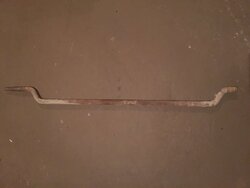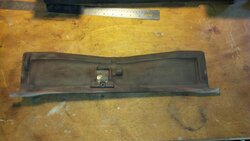droppinloads
Member
Well I'm in N VT only an hour from Quebec so it's quite possible the prior owner of my place bought this up there
Hi all- I bought a house in this past spring that has a VC Encore 2250. I have no experience with VC stoves. The issue is that the damper won't close. I opened it up by taking off the flue collar & the damper bar doesn't really connect to the damper. It catches it for about 1/2in & then the damper just falls back. Is this bar warped possibly? I assume the previous owner over-burned this stove pretty often because a lot of the paint is peeling on the left side. Not sure whether or not to rebuild it or just look into getting a new stove. I'd like to hear thoughts. If all i have to do is fix the damper, i can probably do that on my own. But I have a feeling this thing will end up needing a full re-build. Nothing on the inside of the firebox appears to be warped. So far I bought a gasket kit to replace those, but that's it. Would like to get the damper situation squared away before winter in VT really gears up...


I have to open it up again & take a closer look at that tab. The rod looks just like the one in the picture above. The tab may just be mis-aligned. what happens is the rod catches the damper at first & then slips off. Maybe the tab just needs to be adjustedYep if the rod is straight either the upper fireback is warped or the damper plate itself is damaged and/or the tab that grabs the rod is missing.
The back of the damper plate should look like this - the tab with the screw in the middle is what grab the rod and looks it closed. The adjusting screw you can see on the front center of the damper presses on this tab to adjust the seal.
Lit my new to me resolute acclaim that I got from my buddys father yesterday outside the house. Was in a barn for a while so lit it outside to burn some of the surface rust off. Already replaced the door and top lid gaskets and was planning on replacing the combuster, but yesterday I got a really good controlled burn even when in downdraft mode. He told me that he had replaced it the year before he put the stove in storage due to the fact of needing a larger one for his house. Should I still replace the combuster, or say the hell with it and run it for the season since it worked so well yesterday?? Thanks for the help
If the catalyst was replaced a year ago its probably fine. They are supposed to be good for about 10,000 hours use. As long as you are not seeing much smoke outside when its engaged it shoudl be working.
Jharkin- I read through your Encore rebuild thread- well done & thanks for documenting. I'm thinking I may just replace my upper fireback. Would you say this is a difficult job? It doesn't seem like it should be but then again...
I think he means the combustion package. The Acclaim is a downdraft unit. This usually has a 3-5 yr lifespan with good treatment. If it has been recently replaced it should be ok.If the catalyst was replaced a year ago its probably fine. They are supposed to be good for about 10,000 hours use. As long as you are not seeing much smoke outside when its engaged it shoudl be working.
I think he means the combustion package. The Acclaim is a downdraft unit. This usually has a 3-5 yr lifespan with good treatment. If it has been recently replaced it should be ok.
Last weekend, it was below zero here at night and the house needed more heat! It warmed up since...hence no urgency to put the 2550 in service.
Below zero C ?
On Sunday we had our first hard freeze, it went down to around 25F / -4C overnight. I turned on the gas and we lit the fireplace but not the stove yet. This years wood supply is limited so I am waiting for colder weather.
Today its back up to 70 (22C) again so who the heck knows when that will be...

Agree with BeGreen - never use the ash door to help light off, it creates a blast furnace effect that can crack the stove bottom and get out of control in the blink of an eye.
If you had to replace the door gasket, check every other gasket as well (ash pan, griddle, damper, fire back.
If you dont have one, a probe thermometer for the catalyst is extremely helpful in operating the stove. Condar sells them: http://www.condar.com/Digital_Thermometers.html
Using both stove top and probe temp this is my routine:
A note on cruising temps - Where you need to run the stove will depend on how much heat you need. I find I use catalyst temp more than stove top temp to monitor it. The safe operating range for the catalyst is between 500F and 1700F... I find that trying to keep it in the 1100-1500 range is ideal , any lower and you are probably going to get some smoke from the stake, over 1500 and you have to be careful not to flirt with overfire. Over 1700 will damage the platinum coating and when you get over 1800 you may start to see glowing iron.
- Start the fire as a modified top down. I put in two large splits with a 1/4 super cedar or paper between then cris-cross kindling on top.
- damper open, air wide open , door crack and light it
- Once the flames are well established close the front door, keep air wide open
- Once stop top thermometer reaches 500F+ you can close the damper
- If all works well the catalyst will light off and probe temp should hit 500F and start climbing within a few minutes.. If ift doesnt open the damper again wait 5 minutes and retry
- Once the probe temp crosses 1000F the catalyst is into the ideal zone and you can start closing down primary air in stages (close 1/4, wait 5 min, close 1/4 , repeat) till you get to your desired cruising temp
- At the end of the burn cycle when the catalyst probe temp drops below 800F and you are down to a coal bed its safe to reload. Open the damper, add wood and repeat steps 4,5,6
Stove top temp safe range is anything below 700 IIRC. For me generally staying between 400 and 600 is all I need on any but the coldest days. Most of the time mild days I am cruising with the air control only 1/8 open which will give me a 450-500 stove top and 1200 cat temp. For an overnight burn I fill to the brim with hardwood and run the air full closed which gets me 8-10 hours heat. During the day I cant remember ever cruising on more than 1/4-1/3 open even on the coldest days.
On cold days when you need to run the stove hard for a lot of heat I find its more manageable to load it halfway (maybe 3-4 large splits) more frequently and run the air a bit more open. Running hot on a full load raises the risk of overfiring the cat. I run full loads and low air on milder days and overnight.
Once you get a hang for it the 2550 is not a bad stove to operate, just high maintenance. The main thing to watch out for is catalyst temp runaway if you have a very strong draft or run a full load of fast burning woods like pine. If you do have the cat temp runaway on you, sometimes opening up the air control actually lowers it (counter intuitive, it creates more flame burning smoke up before the cat. It will raise stove top temp as it lowers cat temp). If that fails try opening the damper with the air shut to let it cool down then re-engage.

